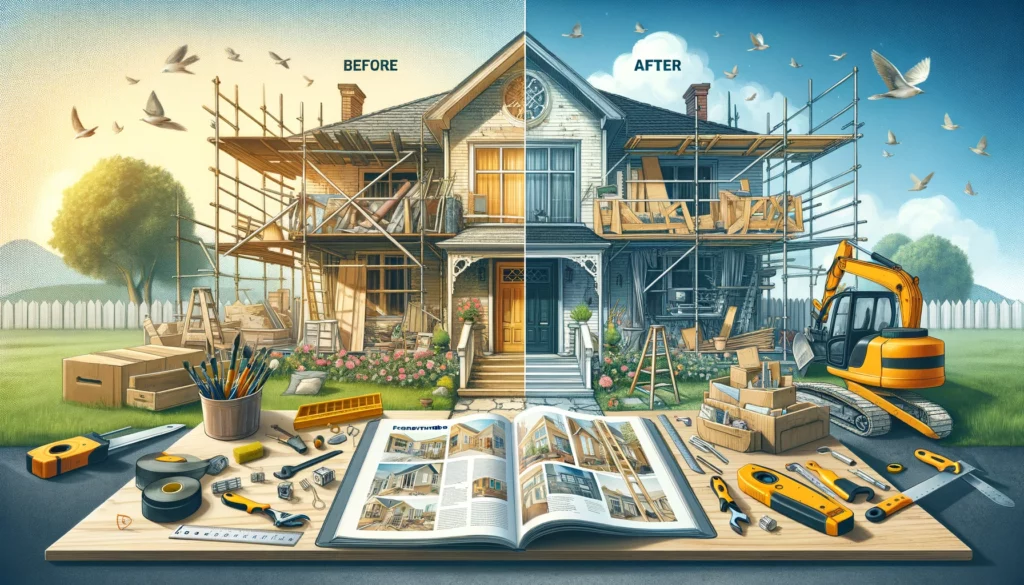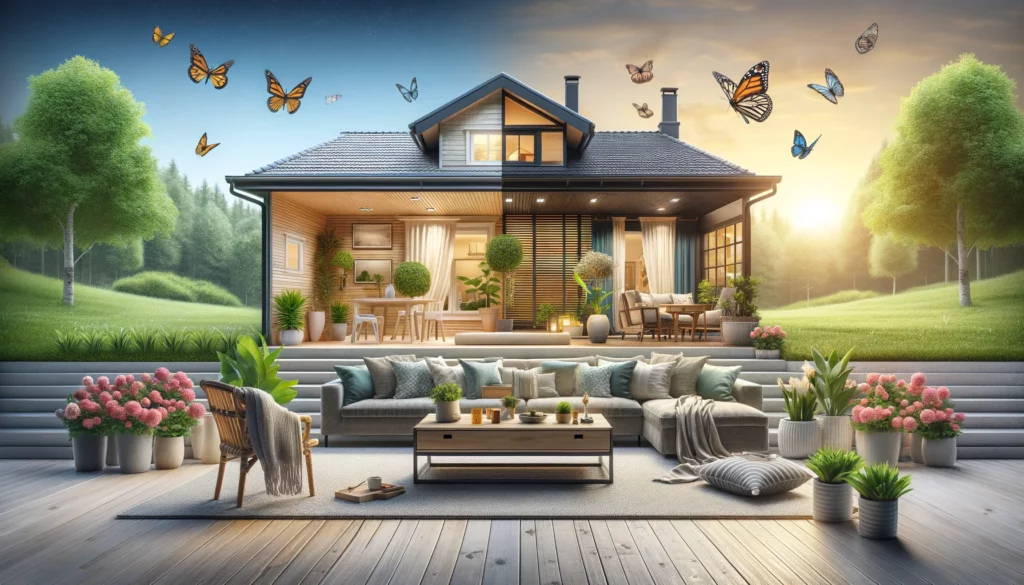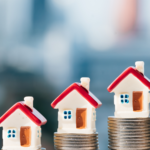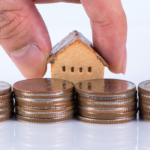Investing in real estate through the BRRRR method—Buy, Rehab, Rent, Refinance, Repeat—has proven to be a lucrative strategy for countless investors. To truly maximize your return on investment, strategic rehabilitation of your property is key. This comprehensive guide will delve into seven key rehab projects that can significantly boost your BRRRR method ROI, supplemented with professional tips and online references to top interior designers and architects for inspiration and guidance.

Key Steps of the BRRRR Method:
- Buy: Purchase undervalued properties with potential for increased value through rehabilitation.
- Rehab: Upgrade these properties to boost their market value and rental appeal.
- Rent: Lease the upgraded properties for steady cash flow.
- Refinance: Secure a new mortgage based on the property’s increased value to recover the initial investment.
- Repeat: Use the capital returned from refinancing to start the process over with new properties.
Focusing on strategic rehab projects, guided by insights from top interior designers and architects, can significantly elevate your investment’s return. This approach not only amplifies property value but also enhances rentability and refinancing terms, paving the way for substantial financial growth.
Understanding BRRRR Method ROI
Return on Investment (ROI) is a crucial metric in the BRRRR strategy, helping investors gauge the profitability of their real estate ventures. In this approach, ROI is not just about the immediate gains from buying low and selling high. It’s intricately tied to the value added through rehabilitation, the income generated from renting out the property, and the capital recouped and leveraged through refinancing.
ROI in the BRRRR Method Explained:
- Buy: The initial purchase price of the property sets the baseline for calculating ROI. Lower acquisition costs can significantly enhance potential returns, especially when properties are bought under market value with the intent to rehab.
- Rehab: Strategic renovations play a critical role in elevating the property’s market value. Investments in rehab should be made with a clear understanding of how much value they add versus their cost, directly influencing ROI by increasing both the property’s worth and its rental income potential.
- Rent: The rental phase introduces steady cash flow, crucial for covering operating expenses and mortgage payments. High-quality renovations can command higher rent, directly impacting ROI through improved operational income.
- Refinance: By refinancing the property at its new, higher value post-rehab, investors can extract equity while potentially securing lower interest rates. This step recoups the initial investment, which can then be reinvested, effectively recycling capital to fuel future projects.
- Repeat: The cyclic nature of the BRRRR method allows for the initial capital to be reused for new investments, compounding the ROI over time as the process is repeated with additional properties.
Step-by-Step Calculation
- Calculate Initial Investment: Sum up all costs involved in buying and rehabbing the property. This includes the purchase price, closing costs, repair expenses, and any other upfront costs.
- Determine Annual Cash Flow: After rehabbing, once the property is rented out, calculate the net income generated. Deduct all operational expenses, including mortgage payments, taxes, insurance, and maintenance costs, from the rental income to get your annual cash flow.
- Refinance and Cash Out: When refinancing, the goal is to withdraw most of the initial investment while securing a new mortgage on the property’s increased value post-rehab. The difference between the new loan amount and the original mortgage (plus any remaining initial investment not covered by the refinance) contributes to your ROI.
- Calculate Total ROI: To find the total ROI, add the equity gained through refinancing to the annual cash flow. Then, divide this sum by the initial investment. Finally, convert this figure into a percentage by multiplying by 100.
Example Calculation
- Initial Investment: $100,000 (purchase and rehab)
- Annual Cash Flow: $12,000 (after all expenses)
- Cash Out Refinancing: New mortgage of $120,000, original mortgage of $80,000, leaving $40,000 cash out and $20,000 of the initial investment recovered.
- Equity Gained: Assume the property’s new appraisal allows for an $40,000 cash-out plus the $20,000 initial investment not covered by the new mortgage.
- Total ROI: ($12,000 annual cash flow + $60,000 equity gain) / $100,000 initial investment = 72%
This simplified example illustrates the basic framework for calculating ROI within the BRRRR strategy. It’s important to note that real-world scenarios might involve more complex calculations, including adjustments for additional expenses, tax implications, and changes in market conditions.
Maximizing ROI with BRRRR:
Achieving a high ROI with the BRRRR method requires a balance between minimizing initial costs (buying undervalued properties and budgeting rehab wisely) and maximizing income (through strategic upgrades that boost rent and property value). Additionally, successful refinancing hinges on how well the rehab and rent phases have increased the property’s value, underlining the interconnectedness of each step in affecting the overall ROI.
1.Kitchen Overhauls: The Centrepiece of Your Investment
The kitchen is often considered the heart of the home, making it a prime candidate for renovation. A well-executed kitchen remodel can yield an impressive ROI.
Expert Tips
- Focus on Functionality: Maximizing storage and workspace can significantly enhance the kitchen’s appeal. Consider adding an island or improving the layout to create a more functional and welcoming space.
- Select Durable Materials: Quartz countertops and high-quality appliances not only look great but are also more appealing to renters and buyers.
Online References
- Houzz.com offers a wealth of kitchen remodeling ideas, showcasing various styles and trends that can inspire your next project.
- ArchDaily features innovative kitchen designs by architects from around the globe, providing unique ideas that could set your property apart.
2.Bathroom Remodels: Small Spaces, Significant Returns
Bathrooms, though typically smaller, play a crucial role in a property’s appeal. Luxurious touches like walk-in showers and modern vanities can transform these spaces.
Expert Tips
- Upgrade Fixtures: Modern, water-efficient fixtures can significantly improve the bathroom’s look and appeal while saving water.
- Incorporate Ample Lighting: Good lighting is crucial in bathrooms. Consider adding layered lighting with LEDs for a modern touch.
Online References
- Pinterest is an excellent resource for bathroom design inspiration, offering endless images of bathroom remodels in various styles.
- Design Milk covers modern bathroom designs, featuring the latest trends in fixtures, tiles, and layout ideas.
3.Exterior Enhancements: Creating a Lasting First Impression
The exterior of your property is the first thing prospective tenants or buyers see. Simple upgrades like new siding and landscaping improvements can drastically improve a property’s aesthetic appeal.
Expert Tips
- Focus on Landscaping: A well-maintained garden can significantly boost curb appeal. Consider low-maintenance but visually appealing plants.
- Refresh the Paint: A fresh coat of paint on the exterior can make an old property look new again. Choose colors that fit the property’s style and the surrounding neighborhood.
Online References
- Garden Design offers extensive resources on garden planning, plant selection, and design ideas suitable for various garden types and styles.
- Tilly Design provides an online landscape design service, allowing collaboration with designers for personalized yard transformations in the U.S. and Canada.
- Houzz is a comprehensive platform for finding landscaping inspiration, connecting with professionals, and sourcing outdoor furniture and decor.

4.Flooring Improvements: Laying the Groundwork for Higher Value
High-quality flooring options like hardwood or luxury vinyl tile enhance the look of your property and are durable and low maintenance.
Expert Tips
- Consider the Property’s Style: Choose flooring that complements the overall design of your property.
- Look for Durability and Ease of Maintenance: Especially in rental properties, you want flooring that can withstand wear and tear.
Online References
- RenovationFind provides detailed insights into various types of flooring available in Canada. Each type is discussed with its pros, cons, and average costs, helping investors understand what might work best for their specific needs.
5.Adding Usable Space: Expanding Horizons for Greater ROI
Adding square footage or converting existing space into more usable areas can dramatically increase a property’s market value.
Expert Tips
- Maximize Underutilized Spaces: Basements, attics, and even garages can be converted into valuable living spaces.
- Ensure Legal Compliance: Before embarking on expansions, check local zoning and building codes to ensure compliance.
Here are some insightful recommendations from First Canadian Construction Corp. and RenoAssistance, detailing popular home additions and considerations in Canada:
- In-law Suites: Ideal for creating private living areas within your home. These additions are beneficial for expanding your living space, particularly when placed on the first floor for accessibility.
- Bedroom Additions: Transforming additional space into a bedroom is a common and needed area in any home. It can include luxurious touches like a covered patio if the structure allows.
- Bump-Outs: Small extensions from existing walls that significantly enhance living space without the need for extensive foundation work or roofing systems, making them a budget-friendly option.
- Basement Renovations: Utilizing your basement for additional living space is one of the easiest and most cost-effective ways to expand your home. It can serve multiple purposes, such as entertainment rooms or guest spaces.
- Garage Conversions: Transforming a garage into a living area or adding a second story to it can create extra space for your family’s needs. However, it’s essential to ensure the structure can support the additional weight.
- Kitchen Additions: Expanding your kitchen can significantly improve your home’s value and functionality. Even small additions can make a big difference in the usability of this space.
- Attic Dormer Additions: If your home has tall attic space, adding dormers can increase usable square footage and add architectural interest to your home’s exterior.
Each of these additions has its unique benefits and considerations, from enhancing living space to boosting your home’s market value. Before starting any project, it’s crucial to understand local building codes and permits to ensure everything is legal and up to standard. For more detailed insights and assistance with your home addition project, consider exploring resources from First Canadian Construction Corp. and RenoAssistance, where you can find comprehensive guides on planning, costs, and types of additions suitable for Canadian homes.
Online References
- RenovationFind Blog offers insights on types of home additions in Canada, such as multi-use garages and basement enhancements, with a focus on maximizing investment through strategic additions. It provides a cost breakdown and factors affecting ROI for each type of addition.
Conclusion
By strategically selecting and implementing these rehab projects, backed by insights from top online resources, you can not only enhance the value of your properties but also optimize the overall ROI of your BRRRR investments. Remember, the goal is to create desirable, high-quality living spaces that stand out in the competitive real estate market.

Frequently Asked Questions
1. Does BRRRR work in Canada? Yes, the BRRRR strategy (Buy, Rehab, Rent, Refinance, Repeat) can be effective in Canada. Its success depends on market conditions, property location, and execution quality. Investors in Canada have applied BRRRR successfully, particularly in areas with strong rental markets.
2. What is the 1% rule in real estate Canada? The 1% rule in real estate suggests that a property’s monthly rent should be at least 1% of its purchase price to ensure positive cash flow. This rule helps investors gauge rental property potential, though it’s more of a guideline than a strict rule, especially in Canada’s varied real estate markets.
3. What are the disadvantages of BRRRR? Disadvantages include the risk of overcapitalization on rehab, potential cash flow issues during vacant periods, refinancing challenges, and the management intensity of handling multiple renovations and tenants. Market fluctuations can also affect the strategy’s success.
4. What is the difference between yield and ROI? Yield refers to the annual income from an investment divided by the investment’s current market value, usually expressed as a percentage. ROI (Return on Investment) measures the efficiency of an investment, calculating the return relative to the investment’s cost. Yield typically focuses on income (e.g., rent), while ROI includes both income and capital gains.
5. Can you sell property for $1 in Canada? Legally, you can sell property for $1 in Canada, but such transactions may have tax implications. The Canada Revenue Agency (CRA) may consider the fair market value of the property for tax purposes, and gift tax rules could apply. Consulting a tax professional is advisable for such transactions.
6. What is the difference between flip and BRRRR? Flipping involves buying a property, renovating it, and selling it for a profit, focusing on short-term capital gains. BRRRR, on the other hand, focuses on long-term wealth building through buying, rehabbing, renting, refinancing, and repeating. The key difference lies in the strategy’s end goal: immediate profit versus building a rental portfolio.





